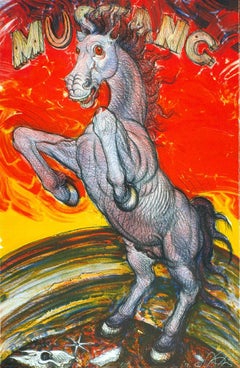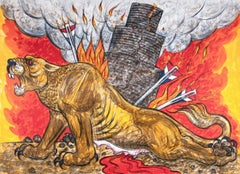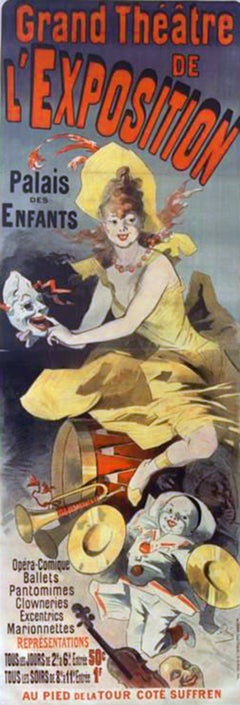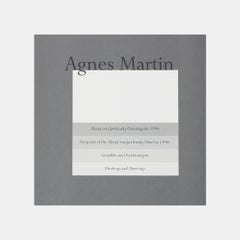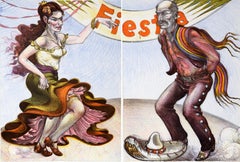Luis Jiménez Art
American
Born in El Paso, Texas, he worked at his father's neon sign studio as a child, which prepared him to make public art.
He studied art and architecture at the University of Texas in Austin and El Paso, earning a bachelor's degree in 1964. He moved to New York City in 1966 after completing his post-graduate work at Ciudad Universitaria, Mexico City, D.F.
He became an accomplished artist and taught art at the University of Arizona and later the University of Houston.
As a sculptor, Jiménez was known for his large polychromed fiberglass sculptures, often of Southwestern and Hispanic themes. His works were often controversial. They are eminently recognizable due to their themes, his original sculptural style, and the colorful, undulating surfaces the artist employed. The finish of his sculptures had more in common with commercial products than with conventional fine art sculptures. Man on Fire (1969) at the Smithsonian American Art Museum in 2023
Jiménez was influenced by the murals of José Clemente Orozco and Diego Rivera. He was very much a contemporary artist whose roots were in pop art, as much as they were in both the modernism of the Mexican muralists and the regionalism of Thomas Hart Benton and Grant Wood. Heroic sculptures were Jiménez's forte, championing the common man in his work. By working in his father's shop on neon signs and sculptures, he was brought in contact with popular culture, which also included lowrider car culture. The brightly painted fiberglass bodywork, often accented with glitter, served as a particularly relevant artistic influence.[5]
While he is best known as a sculptor, Jiménez also made remarkable color lithographs and color drawings in pencil, pastel, and oil stick. He made preparatory drawings for his sculptures, some of which were very large. Most of his sculptures were made of fiberglass, which were cast in a mold, after which they were painted with multiple layers of paint and coated with epoxy. One art expert has noted, "There was no surface on any Luis Jiménez sculpture that was ever any less than six different colors, each airbrushed separately adding a slightly different tone." Jiménez would also often use flake, that glittery quality often seen on lowrider cars, in his paint.
In 1993, Jiménez was a recipient of the New Mexico Governor's Awards for Excellence in the Arts. In 1998 he received a Distinguished Alumni award from the University of Texas in recognition of his artwork.(Biography provided by Cerbera Gallery)
to
6
1
3
3
3
2
4
Overall Height
to
Overall Width
to
3
3
2
2
2
1
1
1
5
1
1
4
6
6,996
3,348
2,513
1,213
6
1
1
1
Artist: Luis Jiménez
Study for Los Lagartos
By Luis Jiménez
Located in Missouri, MO
Luis Jimenez (American, 1940-2006)
"Study for Los Lagartos" 1998
**UNIQUE**
*This was originally an etching in black and white, done in 1996 as an edition of 50. This is 20/50. THEN,...
Category
1990s American Modern Luis Jiménez Art
Materials
Color Pencil, Etching, Lithograph
Study of a Classical Horse and a Modern Horse
By Luis Jiménez
Located in Kansas City, MO
Luis Jimenez
Study of a Classical Horse and a Modern Horse
Year: 1994
4 Color Lithograph
Edition: 40
Paper: Rives BFK, White
Paper Size: 41.75 x 29.5 inches
Image Size: 37 x 22.75 inches
Signed and numbered by hand
COA provided
---------------
Luis Alfonso Jiménez...
Category
1990s Modern Luis Jiménez Art
Materials
Lithograph
Study of Two Classical Greek Horse Heads and a Modern Horse
By Luis Jiménez
Located in Kansas City, MO
Luis Jimenez
Study of Two Classical Greek Horse Heads and a Modern Horse
Year: 1994
2 Color Lithograph
Edition: 28
Paper: Rives BFK, White
Paper Size: 29.5 x 41 inches
Image Size: 16 x 33 inches (irregular)
Signed and numbered by hand
COA provided
---------------
Luis Alfonso Jiménez...
Category
1990s Modern Luis Jiménez Art
Materials
Lithograph
Texas Swing by Luis Jimenez
By Luis Jiménez
Located in Phoenix, AZ
Texas Swing
Luis Alfonso Jimenez 1940-2006
Stone Lithograph Edition of 50
Artist Proof
24 x 18 inches
Luis Alfonso Jimenez
Born, 1940, El Paso, Texas, died 2006, Hondo, New Mexico.
Statement: Luis Jimenez, in his work, celebrates the vitality of life. . . . Jimenez es un hijo de la frontera; he knows its people and the landscape. It is the transformation of these people into art that is his most important contribution to the art of this vast region which stretches between Mexico and the United States.
His subject matter utilizes the popular images of the cultura del norte, and a large part of it is depicted and transformed in the rough and tumble world of la frontera. He is also a son of el norte, and so he uses its materials and explores its emerging, popular myths. The tension and attraction of Jimnez’s work is that he always creates within the space of his two worlds, the Mexicano and the Americano. He constantly shows us the irony of the two forces which repel, while showing us glimpses of the synthesis he seeks. What a gift it has been to us for this talented artist to reflect on the soul of our region. He gives meaning to our existence and history.
Rudolfo Anaya (passage chosen by the artist), A View from La Frontera, Man on Fire: Luis Jimnez, pp. 1, 3, 6Biography: Luis Jimnez was born in Texas to parents who had emigrated from Mexico to the United States; he would later dedicate his 1989 sculpture Border Crossing to his father, who had entered the country illegally. The elder Jimenez was a neon sign designer in El Paso, and Luis worked with him as a youth. His experience working in the neon shop and his fascination with U.S. car culture would both become major influences on his art career.
Jimenez studied architecture at the University of Texas, Austin (UTA), and also took art courses in which he first created sculptures with wood, steel, and fiberglass, choosing the latter because of its association with U.S. popular culture. He subsequently became one of the artists who made fiberglass an acceptable medium in the 1960s. In 1964 Jimenez received his B.S. in art from UTA, and he continued his studies at the Universidad Nacional Autonoma de Mexico in Mexico City.
In 1966 he moved to New York City and worked as an assistant to sculptor Seymour Lipton. Jimnez began to exhibit his art while in New York and in 1972 moved to New Mexico to focus on creating public sculptures, even as he maintained his diverse output of drawings, prints, and lithographs.
Drawing on his early experiences, Jimenez creates works that come from a border perspective, one that draws upon the hybridity bred by culture clashes. Often socially and politically informed, his works speak not only in regional terms, those germane to the southwestern United States, but to broader, more global issues as well. They exhibit a profoundly Chicano aesthetic and sensibility, one that is informed by Mexican and Mexican American traditions, North American popular culture, Chicano cultural icons, and images and themes unique to the Southwest. Death, sexuality, and the struggle of the common people are frequent themes.
Inspired by authors who write in an autobiographical style, Jimenez creates works that function as personal narrative yet are also able to make statements about culture in more global terms. His use of bold colors and lines, a legacy from his fathers work as a neon sign maker, lends a dynamic sensuality to his work, one that is particularly evident in his monumental fiberglass and acrylic urethane sculptural works
Many of Jimenez's works correspond to scholar Toms Ybarra-Fraustos definition of the Chicano aesthetic of rasquachismo, a lowbrow sensibility that appeals to the working class in that it applies to objects that subvert expressions of the mainstream or dominant culture. Creating art that speaks to the people, Jimenez is able to transform regional and culturally specific myths and symbols into globally recognized and relevant icons.
Exhibitions:
In addition to his personal work, Jimenez has been commissioned for numerous public art projects. In 1999 his sculpture Southwest Piet was designated a National Treasure by First Lady Hillary Clinton.
The many exhibitions featuring his work have included Human Concern/Personal Torment (Whitney Museum of American Art, New York, 1969).
The First International Motorcycle Art Show (Phoenix Art Museum, Phoenix, AZ, 1973).
Three Texas Artists (Centre Cultural Americaine, USIS, Paris, 1977),
Recent Trends in Collecting (Smithsonian Institution, Washington, DC, 1982).
Committed to Print (Museum of Modern Art, New York, 1989)
Printmaking in Texas: The 1980s (Modern Art Museum, Fort Worth, TX.
Laguna Gloria Art Museum, Austin, 1990.
The Whitney Biennial (Whitney Museum of American Art, New York, 1991)
Man On Fire: Luis Jimnez (Albuquerque Museum of Art, NM, 1994-95).
47th Annual Purchase Exhibition (American Academy of Arts and Letters, New York, 1995).
Traveling solo exhibition, Working Class Heroes: Images from the Popular Culture (1997-2000).
Jiménez
Collier Gallery has been in continuous operation for over 40 years. Originally located just off Main Street in downtown Scottsdale, Arizona, we have moved to Phoenix to accommodate and showcase our large inventory including:
• Original works by Maynard Dixon, Lon Megargee, Ed Mell, Fritz Scholder, Bill Schenck, Bill Lesch, Luis Jimenez, Greg
Singley, Dan Budnik, and other 20th century Western, WPA and Contemporary Southwestern artists.
• The Fine Art Estate of Lon Megargee
• Vintage rodeo...
Category
1970s Contemporary Luis Jiménez Art
Materials
Lithograph
Mustang
By Luis Jiménez
Located in Lyons, CO
Color lithograph, Edition 50
"Mustang" is a large lithograph depicting a version of a huge public sculpture commissioned for the Denver International Airport. Jiménez' graphic, b...
Category
1990s Contemporary Luis Jiménez Art
Materials
Lithograph
Assyrian Lion
By Luis Jiménez
Located in Kansas City, MO
Luis Jimenez
Assyrian Lion
Yera: 2004
7 Color Lithograph
Edition: 50
Paper: Rives BFK White
Paper Size: 29 x 40.75 inches
Image Size: Same
Signed and numbered by hand
COA provided
Assyrion Lion is a powerfully drawn image referencing the historic changes happening in the Middle East and the accompanying loss and damage of ancient cultural icons. With dramatic effect, Jimènez borrows from the archetypal image of a wounded lioness (see above) and adds a flame engulfed, falling ziggurat (the tower of Babel?) to make his point. The arrows may also be interpreted as modern missiles.
------------------------------------------------------------------------------------------------
Luis Alfonso Jiménez...
Category
Early 2000s Contemporary Luis Jiménez Art
Materials
Lithograph
Related Items
Grand Theatre de l’Exposition, from Les Maîtres de l'Affiche
By (after) Jules Cheret
Located in New York, NY
This lithograph in colors with raised chop mark was printed by Imprimerie Chaix in Les Maîtres de l'Affiche, 1899, on fine woven, heavy stock paper. Measures 15 ¾ x 11 3/8 (40 x 29 c...
Category
19th Century Modern Luis Jiménez Art
Materials
Lithograph
Untitled (from Paintings and Drawings: 1974-1990) Portfolio of ten lithographs
By Agnes Martin
Located in Bristol, GB
Portfolio of ten lithographs on vellum
Edition of2500 (reported)
30.5 x 30.5 cm (12 x 12in) each
Not signed or numbered
Condition upon request
Our mission is to connect art collecto...
Category
1990s Contemporary Luis Jiménez Art
Materials
Lithograph
David Shrigley, Life Is Very Good, 2016
By David Shrigley
Located in Manchester, GB
David Shrigley, Life Is Very Good, 2016
Off-set lithograph
Open edition, unframed
60 x 80 cm (23.62 x 31.5 inches)
Printed on 200g Munken Lynx paper by Narayana Press in Denmark
...
Category
2010s Contemporary Luis Jiménez Art
Materials
Lithograph
Corralled Horse (Artists Proof), 1940s Framed American Modernist Horse Etching
By Ethel Magafan
Located in Denver, CO
"Corralled Horse", is an etching on paper by western artist Ethel Magafan (1916-1993) of a single dark horse standing outside in a wooden fenced corral. Presented in a custom frame, outer dimensions measure 19 x 23 inches. Image size is 10 x 14 inches. This is marked as an Artist Proof
Piece is in very good condition - please contact us for a detailed condition report.
Provenance: Estate of Artist, Ethel Magafan
Expedited and international shipping is available - please contact us for a quote.
About the Artist:
Ethel Magafan
Born 1916
Died 1993
The daughter of a Greek immigrant father and a Polish immigrant mother who met and married in Chicago, Ethel Magafan, her identical twin sister Jenne and their elder sister Sophie grew up in Colorado to which their father relocated the family in 1919. They initially lived in Colorado Springs where he worked as a waiter at the Antlers Hotel before moving to Denver in 1930 to be head waiter at the Albany Hotel. Two years later during the Great Depression Ethel and Jenne experienced at sixteen the tragic loss of their father who had encouraged their artistic aspirations.
He was proud when Ethel, a student at Morey Junior High School, won top prizes in student poster contests sponsored by the Denver Chamber of Commerce and the Denver Post. At East High School in Denver she and Jenne contributed their art talents to the school’s and by their senior year were co-art editors of the Angelus, the 1933 yearbook. At East they studied art with Helen Perry, herself a student of André Lhote in Paris and the Art Institute of Chicago. Her decision to abandon an arts career to teach high school students served as an important example to Ethel and Jenne, who early on had decided to become artists. In a city-wide Denver competition for high school art students Ethel won an eighteenweek art course in 1932-33 to study at the Kirkland School of Art which artist Vance Kirkland had recently established in the Mile High City.
Perry encouraged the Magafan twins’ talent, exposing them to the work of Matisse, Picasso and Cézanne and introducing them to local artists and architects like Frank Mechau and Jacques Benedict whom she invited to speak in her high school art classes. She paid the modest tuition for Ethel and Jenne to study composition, color, mural designing and painting at Mechau’s School of Art in downtown Denver in 1933-34. In the summer of 1934 and for a time in 1936 they apprenticed with him at his studio in Redstone, Colorado.
When they returned to Denver in 1934 with no family breadwinner to support them, their mother insisted that they have real jobs so they worked as fashion artists in a Denver department store. When Jenne won the Carter Memorial Art Scholarship ($90.00) two years later, she shared it with Ethel so that both of them could enroll in the Broadmoor Art Academy (now the Colorado Springs Fine Arts Center) where they studied with Mechau. When the scholarship money ran out after two months, he hired them as his assistants. Along with Edward (Eduardo) Chavez and Polly Duncan, they helped him with his federal government mural commissions. At the Fine Arts Center Ethel also studied with Boardman Robinson and Peppino Mangravite, who hired her and Jenne in 1939 to assist him in his New York studio with two murals commissioned for the post office in Atlantic City, New Jersey. Like their Denver high school art teacher, Robinson also stressed the need to draw from nature in order to "feel" the mountains, which later become the dominant subject matter of Ethel’s mature work after World War II.
Mechau trained her and her sister in the complex process of mural painting while they studied at the Colorado Springs Fine Arts Center, teaching them the compositional techniques of the European Renaissance masters. This also involved library research for historical accuracy, small scale drawing, and Page 2 of 4 the hand-making of paints and other supplies. Ethel recalled that their teacher "was a lovely man but he was a hard worker. He drove us. There was no fooling around."
Her apprenticeship with Mechau prepared her to win four national government competitions, beginning at age twenty-two, for large murals in U.S. post offices: Threshing – Auburn, Nebraska (1938), Cotton Pickers – Wynne, Arkansas (1940), Prairie Fire – Madill, Oklahoma (1940), and The Horse Corral – South Denver, Colorado (1942). In preparation for their commissions Ethel and her sister made trips around the country to pending mural locations, driving their beat-up station wagon, dressed in jeans and cowboy boots with art supplies and dogs in tow. She and Jenne combined their talents in the mural, Mountains in Snow, for the Department of Health and Human Services Building in Washington, DC (1942). A year later Ethel executed her own mural, Andrew Jackson at the Battle of New Orleans, January 8, 1814, for the Recorder of Deeds Building, also in Washington, DC. Her first mural commission, Indian Dance, done in 1937 under the Treasury Department Art Project for the Senate Chamber in the United States Capitol, has since disappeared.
Ethel and her sister lived and worked in Colorado Springs until 1941 when their residence became determined by the wartime military postings of Jenne’s husband, Edward Chavez. They moved briefly to Los Angeles (1941-42) and then to Cheyenne, Wyoming, while he was stationed at Fort Warren, and then back to Los Angeles for two years in 1943. While in California, Ethel and Jenne executed a floral mural for the Sun Room of the Beverly Hills Hotel and also painted scenes of the ocean which they exhibited at the Raymond and Raymond Galleries in Beverly Hills. While in Los Angeles they met novelist Irving Stone, author of Lust for Life, who told them about Woodstock, as did artists Arnold Blanch and Doris Lee (both of whom previously taught at the Colorado Springs Fine Arts Center school. In summer of 1945 Ethel, her sister and brother-in-law drove their station wagon across the country to Woodstock which became their permanent home.
A year later Ethel married artist and musician, Bruce Currie, whom she met in Woodstock. In 1948 with the help of the GI Bill they purchased an old barn there that also housed their individual studios located at opposite ends of the house. The spatial arrangement mirrors the advice she gave her daughter, Jenne, also an artist: "Make sure you end up with a man who respects your work…The worst thing for an artist is to be in competition with her husband."
In 1951 Ethel won a Fulbright Scholarship to Greece where she and her husband spent 1951-52. In addition to extensively traveling, sketching and painting the local landscape, she reconnected with her late father’s family in the area of Messinia on the Peloponnese peninsula in southern Greece. At the same time, her sister Jenne accompanied Chavez on his Fulbright Scholarship to Italy where they spent a productive year painting and visiting museums. Shortly after returning home, Jenne’s career was cut tragically short when she died of a cerebral hemorrhage at age thirty-six. It deeply affected Ethel whose own work took on a somber quality for several years conveyed by a darkish palette, as seen in her tempera painting, Aftermath (circa 1952).
In the 1940s Ethel and her sister successfully made the important transition from government patronage to careers as independent artists. Ethel became distinguished for her modernist landscapes. Even though Ethel became a permanent Woodstock resident after World War II, from her childhood in Colorado she retained her love of the Rocky Mountains, her "earliest source of my lifelong passion for mountain landscape." She and her husband began returning to Colorado for annual summer camping trips on which they later were joined by their daughter, Jenne.
Ethel did many sketches and drawings of places she found which had special meaning for her. They enabled her to recall their vital qualities which she later painted in her Woodstock studio, conveying her feeling about places remembered. She also produced a number of watercolors and prints of the Colorado landscape that constituted a departure from the American Scene style of her earlier paintings. Her postwar creative output collectively belongs to the category of landscape abstractionists as described by author Sheldon Cheney, although to a greater or lesser degree her work references Colorado’s mountainous terrain. She introduced a palette of stronger pastels in her paintings such as two temperas, Evening Mountains from the 1950s and Springtime in the Mountains from the early 1960s.
In 1968 she was elected an Academician by the National Academy of Design in New York. Two years later, based on results of her many summer trips to Colorado, the U.S. Department of the Interior invited her to make on-the-spot sketches of the western United States, helping to document the water resources development and conservation efforts by the Department of the Interior. Her sketches were exhibited at the National Gallery in Washington, DC, and then sent on a national tour by the Smithsonian Institution. Similarly, her previous work as a muralist earned her a final commission at age sixty-three for a 12 by 20 foot Civil War image, Grant in the Wilderness, installed in 1979 in the Chancellorsville Visitors Center at the Fredericksburg National Military Park in Virginia. In the 1970s, too, she taught as Artist-in-Residence at Syracuse University and at the University of Georgia in Athens.
Her many awards include, among others, the Stacey Scholarship (1947); Tiffany Fellowship (1949); Fulbright Grant (1951-52, in Greece with her husband); Tiffany Fellowship (1949); Benjamin Altman Landscape Prize, National Academy of Design (1955); Medal of Honor, Audubon, Artists (1962); Henry Ward Granger Fund Purchase Award, National Academy of Design (1964); Childe Hassam Fund Purchase Award, American Academy of Arts and Letters (1970); Silver Medal, Audubon Artists (1983); Champion International Corporation Award, Silvermine Guild, New Canaan, Connecticut (1984); John Taylor Award, Woodstock Artists Association, Woodstock, New York (1985); Harrison Cady...
Category
1940s American Modern Luis Jiménez Art
Materials
Etching, Paper
David Shrigley, They Were Too Long, 2020 (Discontinued)
By David Shrigley
Located in Manchester, GB
David Shrigley, They Were Too Long, 2020
Off-set lithograph
Open edition, unframed
60 x 80 cm (23.62 x 31.5 inches)
Printed on 200g Munken Lynx paper by Narayana Press in Denmark...
Category
2010s Contemporary Luis Jiménez Art
Materials
Lithograph
Alexander Calder Circus Reproduction Lithograph After a Drawing
By (after) Alexander Calder
Located in Surfside, FL
(after) Alexander Calder
"Calder's Circus" offset lithograph on wove paper after drawings by the artist
Published by Art in America and Perls gallery in 1964 (from drawings done in the 1930's)
these range slightly in size but they are all about 13 X 17 inches (with minor variations in size as issued.) These have never been framed. The outer folio is not included just the one lithograph.
James Sweeny from the introduction “The fame of Calder’s circus spread quickly between the years 1927 and 1930. All the Paris art world came to know it. It brought him his first great personal success. But what was more important, the circus also provided the first steps in Calder’s development as an original sculptor”
Clive Gray...
Category
1930s American Modern Luis Jiménez Art
Materials
Lithograph
CANDACE 1992 Tribute To African American Women, Black Woman Face Portrait
By Elizabeth Catlett
Located in Union City, NJ
ELIZABETH CATLETT
Candace - 10th Anniversary Celebration 1992, A Tribute to African American Women
National Coalition of 100 Black Women, Commemorative Fine Art Poster
Year printed - 1992
Print size - 31.5 x 18 inches
Unsigned, unframed, mint condition
CANDACE is a specially commissioned, lithographic art poster designed by Elizabeth Catlett produced in 1992 for The National Coalition of 100 Black Women to commemorate their 10th Anniversary. Printed using lithographic methods in black ink on heavyweight archival Coventry Rag white printmaking paper, 100% acid free. CANDACE portrays a powerful graphic portrait head of a black woman...
Category
1990s Contemporary Luis Jiménez Art
Materials
Lithograph
DREAMFIELDS I: PINK, Hand Drawn Lithograph, Pastel Abstract Drawing
By Sybil Kleinrock
Located in Union City, NJ
DREAMFIELDS I is a hand drawn original lithograph by the artist Sybil Kleinrock (spouse of the renowned jewelry designer David Yurman. It was printed in seven colors using traditiona...
Category
1980s Contemporary Luis Jiménez Art
Materials
Lithograph
David Shrigley, Some Of My Best Friends Are Pigs, 2019
By David Shrigley
Located in Manchester, GB
David Shrigley, Some Of My Best Friends Are Pigs, 2019
Off-set lithograph
Open edition, unframed
60 x 80 cm (23.62 x 31.5 inches)
Printed on 200g Munken Lynx paper by Narayana Pre...
Category
2010s Contemporary Luis Jiménez Art
Materials
Lithograph
Untitled - Lithograph by Alexander Calder - Late 20th century
By Alexander Calder
Located in Roma, IT
Untitled is a Lithograph on paper realized in second half of the 20th Century by Alexander Calder.
Very good condition including a white cardboard passpartout (32 x 50 cm).
Alexand...
Category
Late 20th Century Contemporary Luis Jiménez Art
Materials
Lithograph
H 5.71 in W 7.49 in D 0.04 in
Circus Acrobat on Horse Silkscreen Print William Gropper American WPA Modernist
By William Gropper
Located in Surfside, FL
William Gropper Silkscreen Print American Modern Art
Circus acrobat on horseback, Dancer
Frame: 26.5 X 21
Image: 23.5 X 18
Old Lower East Side of New York or East European Shtetl. ...
Category
Mid-20th Century American Modern Luis Jiménez Art
Materials
Screen, Lithograph
GRAY AND BLACK ABSTRACT 2002 Signed Lithograph, John Ashbery Suite A WAVE Poem
By Will Barnet
Located in Union City, NJ
GRAY AND BLACK ABSTRACT by the American painter and printmaker Will Barnet is an original hand drawn lithograph, printed using hand lithography on archival printmaking paper 100% aci...
Category
Early 2000s Contemporary Luis Jiménez Art
Materials
Lithograph
Previously Available Items
Fiesta (Diptych), by Luis Jimenez
By Luis Jiménez
Located in Long Island City, NY
Artist: Luis Jimenez, American (1940 - 2006)
Title: Fiesta (Diptych)
Year: 1986
Medium: Two Lithographs on Arches, signed and numbered in pencil
Edition: ...
Category
1980s Folk Art Luis Jiménez Art
Materials
Lithograph
Fiesta (Diptych)
By Luis Jiménez
Located in Long Island City, NY
Artist: Luis Jimenez, American (1940 - 2006)
Title: Fiesta (Diptych)
Year: 1986
Medium: Two Lithographs on Arches, signed and numbered in pencil
Edition: ...
Category
1980s Folk Art Luis Jiménez Art
Materials
Lithograph
Fiesta (Diptych)
By Luis Jiménez
Located in Long Island City, NY
Artist: Luis Jimenez, American (1940 - 2006)
Title: Fiesta (Diptych)
Year: 1986
Medium: Two Lithographs on Arches, signed and numbered in pencil
Edition: ...
Category
1980s Folk Art Luis Jiménez Art
Materials
Lithograph
"Rodeo Queen" Cow Girl Portrait
By Luis Jiménez
Located in Houston, TX
Lithograph portrait titled "Rodeo Queen", by artist Luis Jimenez. Edition 21/50, dated 1981. This piece has been framed with Acrylite OP-3: Ultra violet f...
Category
1980s Pop Art Luis Jiménez Art
Materials
Lithograph
Buffalo Hunt
By Luis Jiménez
Located in Phoenix, AZ
crayon and graphite on paper, framed
proposal for Denver Airport commission
Luis Jimenez is recognized as one of America’s most important artists. At th...
Category
1990s Folk Art Luis Jiménez Art
Materials
Paper, Crayon, Graphite
Luis Jiménez art for sale on 1stDibs.
Find a wide variety of authentic Luis Jiménez art available for sale on 1stDibs. You can also browse by medium to find art by Luis Jiménez in lithograph and more. Much of the original work by this artist or collective was created during the 20th century and is mostly associated with the contemporary style. Not every interior allows for large Luis Jiménez art, so small editions measuring 18 inches across are available. Customers who are interested in this artist might also find the work of Kiki Smith, Betty Woodman, and Corita Kent. Luis Jiménez art prices can differ depending upon medium, time period and other attributes. On 1stDibs, the price for these items starts at $7,500 and tops out at $14,000, while the average work can sell for $10,750.



